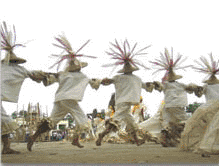Tawo-Tawo Festival
 In the past, Bayawan has always been known as the "Rice Granary of Negros South". Her vast plains have seen glorious days of prolific rice harvest. Today, Bayawan City is known as the Agricultural Capital of the province of Negros Oriental. As an agricultural city, a better production yield is always anticipated, and the presence of the "Tawo-Tawo" or scarecrow had always been a great help to the farmers for several decades. This farmer's creation (others call it ingenuity) has resulted to achieve bountiful yield during harvest - for the "Tawo-Tawo" had been known to be an effective great scare to drive away the pesky little birds-the natives call "Maya" that feed on the ripening golden rice grains. Thus, the birth of the "Tawo-Tawo Festival".
In the past, Bayawan has always been known as the "Rice Granary of Negros South". Her vast plains have seen glorious days of prolific rice harvest. Today, Bayawan City is known as the Agricultural Capital of the province of Negros Oriental. As an agricultural city, a better production yield is always anticipated, and the presence of the "Tawo-Tawo" or scarecrow had always been a great help to the farmers for several decades. This farmer's creation (others call it ingenuity) has resulted to achieve bountiful yield during harvest - for the "Tawo-Tawo" had been known to be an effective great scare to drive away the pesky little birds-the natives call "Maya" that feed on the ripening golden rice grains. Thus, the birth of the "Tawo-Tawo Festival".
The Tawo-Tawo had been conceptualized as an off-shoot of the Fiesta islands trend initiated by the Bayawan Health Club and commenced by Bayawan Habagat Jaycees on 1986, to add more attraction to the Fiesta celebration. Since then, several civic organizations took turns sponsoring this affair until the year 1990 when the LGU of Bayawan decreed it to be a regular part of the annual fiesta.
For several years now the Tawo-Tawo Festival had drawn mixed crowds. Guests from other cities, municipalities and provinces came in droves to witness the street dancing spectacle and field presentation. Each year saw the performance of participating contingents being improvised with artistic innovations. Still, the tableau of rice culture from planting to harvesting replete with the primary
characters: farmers, mayas, scarecrows and carabaos are presented by the contingents in an artistically choreographed movements synchronizing now to the beat of the drums and other musical instruments. In the past, participation is open to schools, barangays, private entities and even neighboring municipalities. Presently, the Tawo-Tawo Festival is confined as a competition among the 28 barangays in the city.
The field presentation has its center piece, the legend “How Bayawan Got Her Name”. In the dance drama presentation, it is told that the coming of the Spaniards in the Philippines as harbinger of the Christian Faith was not exactly met with welcome approval from the natives living in the islands. And Bayawan was among those who resisted the advent of the new faith.
When the Spanish Missionaries set foot on the shores of Bayawan to spread Christianity, the Bukidnons, the so called natives of Bayawan were very recalcitrant to give up their own faith in favor of Christianity. Though peace loving in nature, these natives had a ritual practice involving the act of killing. This kind of ritualistic killing known as “Magahat” practiced by the Bukidnons was to avenge the death of a member of their family.
Those who were converted to Christianity continued to settle near-by where a chapel was built. Those who were dubious of the intentions of the white strangers and thinking that they were here to grab their lands went up to the mountains and waited for the perfect time to launch their assault.
One Sunday morning, while the town’s people were gathered inside the chapel to hear mass, a tragedy happened. In the middle of the Holy Eucharistic Celebration, when the priest hoisted the Holy Host in the act of Consecration, an enraged Bukidnon barged in the middle of the assembly and threw a lance to the priest, killing him.
Thus, the name Bayawan, which is derived from the Visayan word, “Bayaw” or to hoist.
From “What’s in the Name Magahat? (Through Bayawanon Eyes)
by Rolando V. Mascuña, Chairman
Department of Sociology and Anthropology
Silliman University
Dumaguete City




















